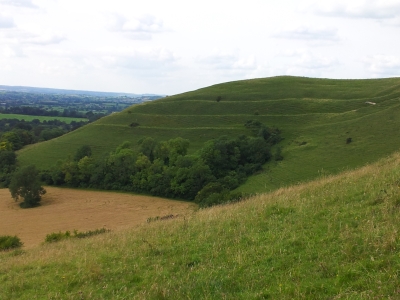Spiral, by Judith Schara, is a book which slightly defies categorisation – part historical fiction, part timeslip, part fantasy, and illuminated throughout by Judith’s evident enthusiasm for her subject. Regardless of the other facets, however, it is as historical fiction that it stands out most clearly to me.

Buy Spiral from Amazon.co.uk
Buy Spiral from Amazon.com
Spiral opens in the modern day, following an archaeologist, Germaine, as she becomes involved with a new dig at Iron Age levels at Maiden Castle, in Dorset. Now this is a place I know well, having lived near there some time ago, and finding it in a book brought back happy memories of exploring its steep banks and ditches. I don’t have a handy picture of Maiden Castle, so here is another hill fort in Dorset, Hambledon Hill.

In the story, however, modern Maiden Castle is not just a fun place to roam around, but the focal point of competing ambitions – academic, political, religious, reputational, and monetary. Germaine finds herself caught up in this vortex, but is only dimly aware of it. Driven by her own need for recognition, she puts herself in life-threatening danger – and we are plunged into the world of Iron Age Britain, and the life of a girl called Sabrann.
From here on the story follows dual tracks – for the most part we follow Sabrann and an assortment of companions out of Britain, into northern France and finally to Carthage. There is a lot of voyaging, and neither the travellers nor the reader can spend long at any of the fascinating locations visited. Sabrann is under constant threat, both physical and spiritual, and has to learn how to recognise and trust friends amongst a crowd of enemies. Meanwhile from time to time we return to glimpses of Germaine’s modern world.
Spiral is simply the first book in a series (“Book One of the Spiral in Time“), and so it ends with a great many issues unresolved. Sabrann and her friends have survived great peril, but are separated and do not know what the future will bring. Germaine is recovering, but unsure what to do next. As readers, we have been introduced to some of the deep connections between people of the two time periods, but a great deal remains unknown. One assumes that further revelations will follow in later books.
Now, I must admit that I prefer books which are self-contained, and there is a certain frustration in getting to the end and finding major plot themes not tied up. I can, and do, enjoy, a connected series of books, but not so much a multi-volume work of this kind. Other readers will perhaps appreciate this style of presentation more than I, and Judith makes it quite clear that you only have Book One in your hands.
The fantasy elements enter in a couple of ways. First, there are very occasional overt demonstrations of magical or spiritual power. More commonly though, fantasy enters through the constant level of imminent danger, and Judith’s chosen styles of characterisation. The book’s central characters are quite nicely rounded, but some people that they encounter, especially in Carthage, have the slightly larger than life, archetypal quality of fantasy rather than “straight” historical fiction. In Carthage the standard fantasy trope of “organised religion = bad, personal spirituality = good” is very prominent. Again, readers may differ in their response to this.
I mentioned timeslip, but Judith’s handling of this is innovative. Germaine and Sabrann are connected in a profound way, but it is not altogether clear (at the end of Book One) how much they recognise each other’s reality, or whether they will ever be able to. What we have is a pattern of recapitulation and discovery rather than time travel, and it will be interesting to see how the pattern is further developed.
Technically the Kindle edition I read was well produced and edited, and a pleasure to read.
For me, a strong 4* book. I would have enjoyed longer spells of time at the places visited, especially as Judith has a clear knowledge of and delight in her subject. The continual focus on danger and probable death from any of multiple causes distracted me from simply enjoying and immersing myself in ordinary life. I realised that as a reader (and writer) I tend to enjoy everyday life scenarios more than high profile crises! And, as mentioned, I found the lack of closure within the book a little frustrating. However, I very much appreciated the focus on Iron Age culture outside the Roman experience, along with the multicultural issues faced by the characters. Sabrann herself was a memorable character – more so than Germaine, who has been given less narrative space so far.
I will certainly be looking out for other books in the series.
